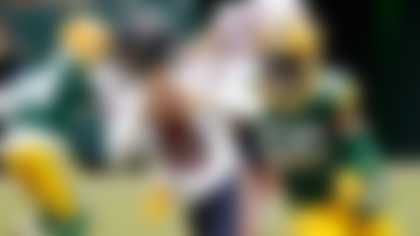I was introduced to pro football during the mid-1980s.
Growing up on the East Coast, my cable-free TV set offered the Jets and Giants on Sundays along with precious Monday night fare. Little else.
It was a chore to track teams from other burgs unless NBC or CBS screened highlights of distant action in Green Bay or St. Louis. You'd see flashes of Joe Montana flinging a 43-yard dart to Jerry Rice before they tugged you back to local bouts.
Falling hard for the sport, I bought every season-preview rag I encountered while spending long after-school hours wading through my weathered NFL Encyclopedia, which told of campaigns dating back to ancient days. I formed mental images of those gridiron stars who came before my fandom -- and vowed to know every player currently under contract.
My tools were prehistoric: dense stacks of football cards; self-tabulated statistical databases kept on an IBM desktop the size of a suitcase; notebooks stuffed with rankings, ratings, drawings and doomed predictions.
Not much different than what I do today, but those early years set my heart on fire for football. I'd obsess all week about the upcoming Sunday, when NFL players would rise again to author unpredictable high-dramas in cities that seemed as far away as Alderaan.
When I think of my favorite players, the list changes constantly -- so consider this more a snapshot. The older ones came to me in those early days of blossoming involvement; the newer stirred a more cynical heart many years later -- certainly a tougher task.
Here we go:
Lawrence Taylor
Outside linebacker; New York Giants (1981-1993)
Taylor was a central figure in the earliest games I witnessed. The Giants were rounding into a Super Bowl contender under Bill Parcells when I hit the scene in '85.
We're trained to scan the quarterback, but Giants tilts were unusual, with broadcast teams crooning for minutes at a time about "the highly disruptive Lawrence Taylor." John Madden would get busy unfurling sea poems detailing how the unhinged linebacker could single-handedly neutralize an offense. Armed with scant knowledge of defensive play, I struggled to understand how one would-be tackler could wield this kind of an impact. Taylor was the ideal teacher, spinning immense chaos each Sunday while growing in scope as cameras showed him barking along the sideline, jawing with Parcells and firing verbal bombs at teammates before returning to cause more on-field wreckage. Come Monday, the morning paper would arrive with back-page photos and penned chronicles of Taylor's feats the day before. On a Giants team filled with characters, he was the master entertainer.
Al Toon
Wide receiver; New York Jets (1985-1992)
Those Giants rosters forged two titles under Parcells, but fate was less kind to the Jets. New York's other team was disgraced by toiling in a venue titled Giants Stadium -- and often to lesser results. The 1980s saw Gang Green put together a string of promising seasons, though, powered in part by Al Toon. The acrobatic, strong-handed wideout seemed to pull the Jets through endless rough patches with sticky-finger grabs that left cover men bewildered.
A poetic high point for Toon arrived in Week 16 of 1988, when the eliminated Jets knocked the 10-5 Giants from the playoff picture. Big Blue's fate was sealed when Ken O'Brien hit Toon for the winning score with 37 seconds remaining, leaving Giants defensive coordinator Bill Belichick mumbling blue language on the sideline before CBS dispatched Tri-State viewers for an on-time triple-header screening of 60 Minutes, Murder, She Wrote and A Very Brady Christmas.
To my young eyes, Toon was the first wideout I observed who seemed to pull off something amazing every time out. Throwing the ball with friends after school on yellowed November fields, the goal was to mimic his fingertip snatches -- minus a lathered-up Jets throng booming in unison: TOOOOOOOOOOOON.
Randall Cunningham
Quarterback; Philadelphia Eagles (1985-1995), Minnesota Vikings (1997-99), Dallas Cowboys (2000), Baltimore Ravens (2001)
Those old Giants squads met their match in Cunningham, who exploded into public consciousness (mine, at least) with a dose of new-age spell-casting during a Monday night clash with the Giants in October '88. With the Eagles trailing 3-0, Cunningham rolled to his right and directly into the sights of surging All-Pro linebacker Carl Banks. The Giants heavy dove at Randall's knees, but a tumbling Cunningham amazingly planted his free left hand against the turf to keep his balance, popping upright and -- with Big Blue linebacker Harry Carson about to crush him -- flung the ball off his heels to a waiting Jimmie Giles in the end zone.
One year later, Cunningham befuddled the Giants again in a December bout in the Meadowlands with a 91-yard punt from deep in Philly's end zone. Watching the game with my father, we sat in stunned amazement as Madden and Pat Summerall attempted to unpack an NFL quarterback booting what remains the third-longest punt in NFL history.
Cunningham did Lamar Jackson things long before Lamar Jackson arrived to earth. For all the heroics of his younger years, though, my fascination with Cunningham doubled and tripled with his post-retirement return to the league in 1997. One season later, he authored one of football's finest comeback tales with a 34-touchdown campaign that saw him lead the white-hot Vikings to a 15-1 record and the NFC title game. That affair ended in the cruelest of gaffes when Gary Anderson -- who had just become the first kicker in league lore to convert every field goal and point after in a single season -- flubbed a 39-yard field goal to allow the Falcons back into a game they would eventually win in overtime. Two weeks later, the nation watched Denver fry Atlanta in Super Bowl XXXIII -- each of us wondering what could have been had Cunningham squared off with John Elway.
Troy Aikman
Quarterback; Dallas Cowboys (1989-2000)
The Cowboys aren't everyone's cup of tea, but the '90s juggernaut under Jimmy Johnson was history in motion. You could sense something spicy baking in the oven when the '91 squad waltzed into Chicago and outclassed the Bears in a physical 17-13 wild-card win at Soldier Field. It's easy to forget Dallas carved out that victory with backup passer Steve Beuerlein under center. Aikman suited up the following week and fell victim to the Lions, but returned in '92 to help the 'Boys capture their first Super Bowl since 1977. Rinse and repeat in '93 and '95. He is nitpicked for his numbers -- Aikman never tossed more than 23 touchdowns in a season -- but he made a barrage of huge lobs for a team boasting a dominant defense, offensive line and Emmitt Smith in the backfield. His leadership was underrated inside a locker room stuffed with ego and some of the game's more unique personalities.
Christian Okoye
Running back; Kansas City Chiefs (1987-1992)
Okoye hails from a time when bruising runners looked twice as imposing due to a trend at the time of wearing gargantuan shoulder pads. I wouldn't call Okoye a one-hit wonder, but his six-year career for the Chiefs might be lost in time if not for his 1,480 yards and 12 scores for a frisky Kansas City club in '89. The 6-foot-1, 253-pound bowling ball matched his Nigerian Nightmare nickname with outings that left the enemy in shambles. It's fair to ask what sort of role he'd play in today's NFL as a big-body thumper who caught just two passes for 12 yards that season.
Nerdy side note: In high school (minus an automobile or girlfriend), I became obsessed with APBA, a football simulation game for the PC. Real teams, real players -- and the chance to replay full seasons. When the '89 campaign arrived by mail (in floppy disc form!) I made a habit of unleashing that Chiefs offense on repeat to see just how much destruction I could generate on the ground. In an outing against the Oilers roster, Okoye blew the doors off Houston with 300-plus yards rushing and four scores. I asked Steve DeBerg to pass twice all contest.
QB Bernie Kosar and RB Earnest Byner
Kosar: Cleveland Browns (1985-1993), Dallas Cowboys (1993), Miami Dolphins (1994-96)
Byner: Cleveland Browns (1984-88 and 1994-95), Washington Redskins (1989-1993), Baltimore Ravens (1996-97)
I could make this list a baker's dozen of Browns players, but that feels dangerously niche for NFL.com. My growing love of football during occasionally tumultuous middle school and high school years was fueled by a deep obsession with Cleveland's football squad.
I've gushed previously about my relationship with those old Browns teams. It started with Bernie Kosar, who won fans over with his Ohio roots, brainy pre-snap machinations and aggressive approach to the passing game. While Bernie ran like a duck on sand, defenses soon learned that his ability to thread the needle 40 yards downfield was problematic to the AFC Central and beyond. Bernie was the ideal teammate and showed as much in front of a national audience when he kneeled beside Earnest Byner to comfort the team's workhorse runner after his fateful fumble against Denver in the AFC title game following the '87 season.
Browns fans worth their salt know the team would never have reached that game without Byner thriving as a do-everything weapon who could stir chaos on the ground and kill front sevens as a pass-catcher. He played with passion and demanded those around him do the same. Together, these two players turned the Browns into a watchable force before each winning Super Bowls of their own with different teams after departing Cleveland.
Tom Brady
Quarterback; New England Patriots (2000-2019), Tampa Bay Buccaneers (2020-present)
While the Patriots often serve as an annoyance, I rarely felt the same about Brady. I always found myself siding with TB12 during his endless wars against Peyton Manning. I felt the same way when Brady exited the tunnel before facing Seattle in Super Bowl XLIX. Mired in the crucible of Deflategate, Brady was cascaded in boos from a Seattle-heavy crowd. Sitting in that stadium, though, something about the Jumbotron-sized figure of Brady marching toward the field stays with me still. I'm almost surprised to find him on this list, but I see him as the greatest quarterback of all time -- and one of the few players whose multilayered careers I'll have watched in person from wire to wire with growing fascination.
Bo Jackson
Running back; Los Angeles Raiders (1987-1990)
I fell for Bo the same way a million kids across America fell for Bo. There seemed to be nothing he couldn't accomplish. If Michael Jordan claims a baseball career, it appears as a lark next to Jackson's 107 home runs for the Kansas City Royals between 1987 and 1990. For the Raiders, Jackson never crossed 1,000 yards in a season, the result of sharing carries with Hall of Fame runner Marcus Allen. The numbers, though, matter not. Bo operated as a highlight-reel tornado, detonating The Boz on Monday Night Football, turning linebackers into toddlers and delivering the NFL's longest runs in 1987 (91 yards), 1989 (92) and 1990 (88). That '90 season ended with a hip injury during a playoff win over the Bengals, cutting Bo's career short after four seasons. For all the hoopla over his juiced-up Tecmo Bowl persona, the real-world Bo Jackson outshined the pixelated fantasy.
Brett Favre
Quarterback; Atlanta Falcons (1991), Green Bay Packers (1992-2007), New York Jets (2008), Minnesota Vikings (2009-2010)
What to utter about Favre that we don't already know? He changed the quarterback position from the inside out with a fountain of towering deep shots, magical escape acts and game-altering plays drawn up in the dirt. More personally, Favre served as an anchoring force when the Browns moved to Baltimore and left me minus a team to root for from '96 through '98. Instead of rising and falling with one club's result, I spent Sundays surveying the league through a wider lens. I kept focusing on Favre, though, who specialized in lighting up sports bars with last-minute wonderment. During a trio of seasons when I could have justified walking away from a league that saw my childhood team zapped into dark matter, Favre only magnified and nurtured my love for the sport.
Follow Marc Sessler on Twitter @MarcSessler.












